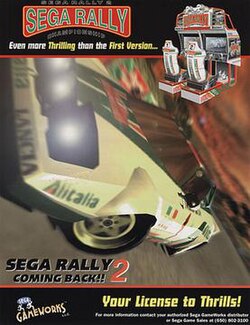Top Qs
Timeline
Chat
Perspective
Sega Rally 2
1998 video game From Wikipedia, the free encyclopedia
Remove ads
Sega Rally 2[b] is an arcade racing game developed by Sega for the Model 3 arcade hardware.[3] It is the sequel to 1995's Sega Rally Championship. The game was first released in arcades in February 1998, and was later ported to the Dreamcast, becoming one of the console's earliest titles when it was released in Japan on January 28, 1999. The Dreamcast version was released in Europe as a launch title on October 14, 1999, and then in North America on November 27.[4] A Windows version was released in Japan and Europe that same year, with the North American release following suit in November 2000,[2] where it was published by Mattel Interactive.[5]
Remove ads
Gameplay
Summarize
Perspective
As with the predecessor, Sega Rally Championship, the object of the game is to successfully drive along a track while reaching checkpoints and thus be rewarded with more time to enable the player to reach the goal. The handling of the car changing with the different road surfaces has also been retained.[6] Sega Rally 2 added new vehicles, new environment settings for the circuits (including snowy tracks and a course set on an island), as well as including multiple circuits in each environment type. An updated version of the original game's Desert track is also included. A hand brake was added to the controls.[6]
The arcade version has two modes: a Championship Mode, in which the player races against opponent cars, and a Practice Mode, in which there are no other cars on the tracks and the player races to beat the clock.[7] The Dreamcast and PC versions of the game also include a "10-year championship" mode.[8] The Dreamcast version, ported using Windows CE, has a frame rate half that of the arcade version.[9]
The Toyota Celica GT-Four ST-205, Lancia Delta HF Integrale and the unlockable Lancia Stratos HF returned from the original game as selectable cars, along with newer Toyota and Lancia cars, as well as cars from Mitsubishi, Subaru, Fiat, Peugeot, Renault, and Ford.
Remove ads
Development
Development on the game began in March 1997, with producer Tetsuya Mizuguchi at the helm.[3] Roughly half of the development personnel were Sega AM Annex staff, with the other half taken from a number of other internal studios at Sega.[10] The majority of the development staff for the original Sega Rally Championship worked on Sega Rally 2.[11] The team created their own development tools for the project.[10]
Remove ads
Reception
Summarize
Perspective
Reception
The game received favorable reviews on both home platforms. Lamchop of GamePro said of the Dreamcast version in one review, "It looks and feels like the arcade version, and there's no slowdown at all even in two-player split screen mode. SR2 is worth at least a rental for Dreamcast owners who enjoy coin-op racing thrills on the comfort of their own couch."[34][e] In another GamePro review, The D-Pad Destroyer said, "Rally fans and arcade racers will love this dirt-slidin' good time, but gamers weaned on the post-Gran Turismo racing revolution may wince at the game's archaic checkpoint system. Still, as far as rally racing goes on the Dreamcast, there really is nothing quite as fun as Sega Rally 2."[35][f] Jeff Lundrigan of NextGen said in its January 2000 issue that the same Dreamcast version "is not the sort of game you beat. Instead, it beats you."[32] A year later, in its January 2001 issue, Jim Preston called the PC version "a fun and pretty arcade rally game that redirects the blood from your brain to your foot."[33] In Japan, Famitsu gave the Dreamcast version a score of 36 out of 40.[23]
Also in Japan, Game Machine listed the arcade version in their April 15, 1998 issue as the most-successful dedicated arcade game of the month.[36]
The Dreamcast version was the best selling Dreamcast game in Japan during 1999, selling 290,000 units.[37] In the UK, it was the 2nd top selling Dreamcast launch game after Sonic Adventure.[38]
Remove ads
Notes
- Mattel Interactive and Empire Interactive published the Windows version in North America and Europe, respectively.
- Sega Rarī Tsū (セガラリー2), also known as Sega Rally Championship 2
- In Electronic Gaming Monthly's review of the Dreamcast version, one critic gave it 9.5/10, and the rest gave it each a score of 9/10.
Remove ads
References
External links
Wikiwand - on
Seamless Wikipedia browsing. On steroids.
Remove ads

